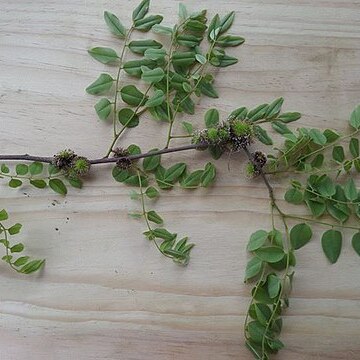A tree 25-35 ft. high, with a trunk 1-2 ft. thick, and unarmed finely grey-velvety woody branchlets. Petioles woody, 6-9 lines long; leaves 3-4 in. long, with 11-13 oblong shining coriaceous bluntish leaflets 12-20 lines long, 8-9 lines broad, rounded at the base, opaque and finely grey-velvety below, on petiolules a line long. Flowers in densely congested sessile axillary panicles. Pedicels nearly obsolete. Calyx campanulate, finely brown-velvety, 1/8 in. deep, the deltoid teeth reaching a third down. Corolla 3.5 lines long, reddish, the keel shorter than the wings and unguiculate orbicular recurved standard. Stamens equally diadelphous. Ovary linear, densely silky, with a distinct pedicel. Pod not seen.
A shrub or small tree. It loses its leaves during the year. It grows 4-12 m tall. The branches are stiff and erect. The crown is open. The bark is grey brown or reddish. It is rough and cracked. The leaves are compound with 4-7 pairs of leaflets and one at the tip. The leaflets are 2-3 cm long. The flowers are white and appear before the leaves. They occur in dense heads up to 10 cm across. Each flower is small and pea like. The fruit is a flat, thin brown pod. It is 7 cm long by 1.5 cm wide. It has a sharp tip. There are 1-2 seeds.
Leaves up to 16 cm long; petiole 1.5–2 cm long, fulvous-puberulous, glabrescent; petiolules 1.5–3.5 mm long; leaflets (3)4–6(7) on each side of the rachis, 1.5–5(6) × 0.8–3 cm, ovate to elliptic or oblong-ovate, rounded or obtuse or acute at the apex, rounded at the base, thinly appressed-puberulous or shortly tomentose to subsericeous on both surfaces; lateral nerves 4–6 pairs and reticulation scarcely visible; stipules caducous.
Standard 7–8 mm in diameter, subcircular, apex emarginate or retuse, base narrowly decurrent into a short claw; wings obovate, as long as the standard, auricle rounded, claw c.3 mm long; keel petals shorter and broader than the wings, incurved, usually free, slightly overlapping at the apex, claw c.3 mm long.
Inflorescence usually an aggregate of small showy panicles or cymose racemes 3.5–6 cm long, borne precociously in the axils of fallen leaves, rarely also in axils of leaves of new shoots, fulvous-tomentellous or puberulous; bracts 1 mm long, bracteoles linear, 1.5 mm long, often present at anthesis.
Unarmed slender shrub or small straggling tree up to 10 m tall; crown spreading; bark rough, grey or dark brown, deeply fissured.
Calyx 3–4.5 mm long, pubescent-glabrescent; upper teeth rounded, the others acute to subacute.
Young parts fulvous-subsericeous or shortly tomentose; branchlets with reddish cortex.
Ovary 2–3-ovulate, tomentose or glabrous; style glabrous; stipe 2–3 mm long.
Pod flat, 1–3-seeded, 3–5.5 × 1.7 cm, fulvous-velutinous or glabrous.
Flowers white, 8–10 mm long, sweet-scented; pedicels 3–6 mm long.
Stamens in a single bundle or in 2 bundles of 5.
Ripe seeds not seen.


